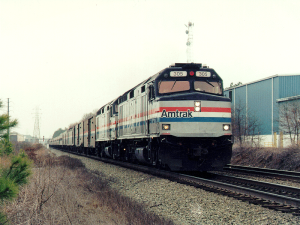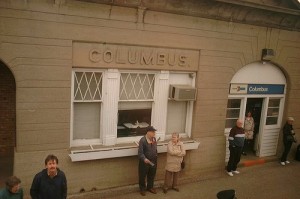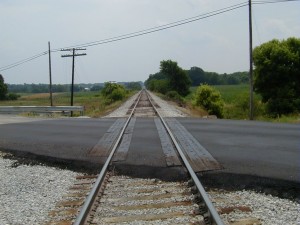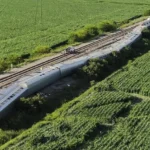Riding in the Head End of the ‘Builder’
Back in the mid-90s, I was working on a book about train travel and had gotten a lot of help from Amtrak. I met with several of their key people in Washington, the guys in charge of maintenance and food preparation, for example. And during a number of my train trips I had spent time talking to a lot of the on-board crews – conductors and train attendants and dining car staffs.
The one crew member I hadn’t been able to spend any time with was an engineer. To that end, I had asked for a ride in a locomotive, but those requests are rarely granted and I had little expectation that it could be arranged. So you can imagine my delight when I was told arrangements had been made for me to spend some time in the head end during a trip to Seattle I had scheduled a month or so later on the Empire Builder.
In Chicago before our departure, I was instructed to hop off when the train reached Milwaukee and head up to the locomotive where an Amtrak employee would be expecting me.
We left Chicago on time and rolled into Milwaukee just before 4:00 p.m., right on schedule. As I left my sleeper, I told the car attendant that I would be riding in the head end for a while and he whistled appreciatively. “Wow,” he said, “they never let people go up there.”
Up by the lead unit (there were two pulling the Builder), I met Craig Willett, an Amtrak road foreman, who was going to be my escort and guide. He gestured to the metal ladder running up the side of the locomotive and said, “OK, let’s go.” I shoved my note pad into my hip pocket, clambered up the metal rungs and climbed into the cab. The engineer himself, Bob Kolkman, swung around in his chair, grinned, and said, “This must be the writer.”
The assistant engineer had already taken a seat in the second unit and I was ushered into his vacated chair on the left side of the locomotive cab. The first thing I noticed was that there were no controls in front of me. The assistant engineer is there to provide a second pair of eyes and relief for the engineer if and when he needs it. When that happens, they just swap chairs.
 My head end ride was in a vintage F40 diesel-electric locomotive, a brutish workhorse machine that has since been replaced by newer, more powerful engines. The F40 had few of the features now found on the new locomotives. For example, air conditioning in the F40 cab was accomplished by opening the windows. After we got underway, I also noticed that the ride up there in the locomotive was rougher – maybe “stiffer” is a better word – than in the coaches or sleepers.
My head end ride was in a vintage F40 diesel-electric locomotive, a brutish workhorse machine that has since been replaced by newer, more powerful engines. The F40 had few of the features now found on the new locomotives. For example, air conditioning in the F40 cab was accomplished by opening the windows. After we got underway, I also noticed that the ride up there in the locomotive was rougher – maybe “stiffer” is a better word – than in the coaches or sleepers.
Railroad engineers sit on the right side of the cab because track-side signs and signals are on that side. Most laymen don’t realize that, however, and assume that the engineer is the person sitting in the left-hand chair.
 An hour after leaving Milwaukee, we pulled into the little town of Columbus, Wisconsin, and there on the platform, right out of a Norman Rockwell painting, stood a father with two little boys, both waving enthusiastically … at me, the guy in the left-hand seat! Bob Kolkman laughed and said, “They think you’re driving. Better wave back or you’ll give us all a bad name.” I did and I must say that, before or since, I never felt so puffed up and so foolish at the same time.
An hour after leaving Milwaukee, we pulled into the little town of Columbus, Wisconsin, and there on the platform, right out of a Norman Rockwell painting, stood a father with two little boys, both waving enthusiastically … at me, the guy in the left-hand seat! Bob Kolkman laughed and said, “They think you’re driving. Better wave back or you’ll give us all a bad name.” I did and I must say that, before or since, I never felt so puffed up and so foolish at the same time.
As you can imagine, the visibility is wonderful from the locomotive cab – you’re quite high, of course, and have a panoramic view, 180 degrees to the front and both sides.
As a safety feature, there is a device called an alerter in every locomotive cab. If the engineer doesn’t adjust the speed or touch the brakes or blow the whistle for a period of 20-25 seconds, a strobe light flashes and a horn sounds. Once that happens, the engineer must press a button on the instrument panel or the train will automatically come to a stop.
 There are lots of grade crossings and the whistle blows constantly. In those open air cabs, the noise was deafening. I was given ear plugs for that reason, but discarded them after 10 or 15 minutes because I had trouble hearing what Willett and Kolkman were saying.
There are lots of grade crossings and the whistle blows constantly. In those open air cabs, the noise was deafening. I was given ear plugs for that reason, but discarded them after 10 or 15 minutes because I had trouble hearing what Willett and Kolkman were saying.
Another hour passed and I found myself settling into a more comfortable routine. Willett and Kolkman were relaxed and friendly and I no longer felt like an intruder in their exclusive domain. Willett had taken the initiative and steered the conversation, but Kolkman joined in with an occasional comment. He was clearly focused on his job, however, and I also noticed that Willett managed to be facing forward most of the time with his eyes on the track ahead, even when chatting with me.
(More about this rare experience tomorrow)



